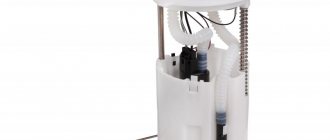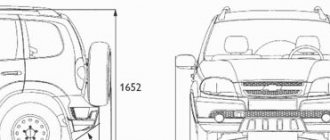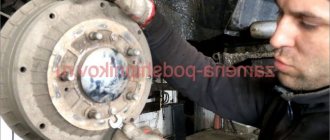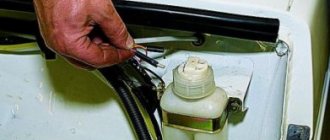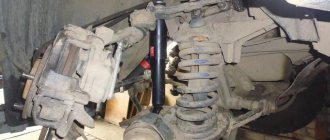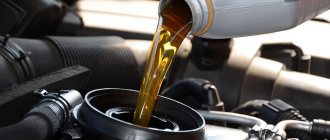Technical characteristics of the Niva 2131 car
The five-door Lada Niva 4x4 is a compact, unpretentious, reliable SUV designed for transporting passengers and luggage at air temperatures from -40 °C to +45 °C. This car is distinguished by a suspension that provides excellent ride comfort and absolute immunity to road irregularities. The five-door VAZ 2131 is the most spacious car in the Niva 4x4 line.
Dimensions, weight, load capacity
The vehicle has characteristics such as length, width, height. These indicators help the driver assess how much space the car occupies on the road. Length is the distance between the maximum protruding parts in front and behind. The width is determined by the boundaries of the side mirrors. Height is measured from the surface on which the vehicle is located to the highest point on the roof of the vehicle.
All this data is not difficult to find in the vehicle operating manual. Dimensions Niva 2131:
- length – 4240 mm;
- width – 1814 mm;
- height – 1640 mm.
For Niva 2131, the outer minimum turning radius along the axis of the front wheel track is 6.45 m. Equally important indicators are weight (curb weight) and load capacity. The first is the total mass of a set of standard equipment, all necessary consumables (including engine oil, fuel, etc.), as well as the weight of the driver. Baggage and passengers are not included. The 5-door Lada Niva 4x4 weighs 1370 kg.
Payload capacity is the difference between the permissible maximum weight and the curb weight. For Lada Niva 2131, the first indicator is 1870 kg, therefore, the carrying capacity of this vehicle is 500 kg. Permitted maximum weight (PMM) is calculated as the sum of the curb weight of the car and the maximum total weight of luggage and passengers (in the amount provided for by the design).
Custom Options
Technical characteristics of the Niva 2131 include operational features, engine properties and fuel and speed parameters.
Basic data on the model under consideration are presented in the table:
Definition
| Index | |
| Body type | all-metal, monocoque, 5-door station wagon |
| Body class | SUV |
| Layout diagram | all-wheel drive, longitudinal engine |
| Number of places, people | 5, with the rear seat backs folded – 2 |
| Trunk volume, l | 420, with seats folded – 780 |
| Transmission type | 5MT |
| Wheelbase, mm | 2700 |
| Front/rear wheel track, mm | 1440/1420 |
| Front/rear brakes | Disc/drum |
The vehicle ground clearance (clearance) with a static tire radius of 314 mm (185/75R16) is:
- to the front suspension cross member - at least 221 mm,
- to the rear axle beam – 213 mm.
- front – independent, on wishbones, spring, with hydraulic telescopic shock absorbers and anti-roll bar;
- rear - dependent, lever, spring, with hydraulic telescopic shock absorbers.
For a 4x4 vehicle, the wheels account for 100% of the weight. That is why an all-wheel drive vehicle has a traction force that is approximately 2 times greater than a vehicle with a 4x2 wheel arrangement. Thanks to the front wheels installed at certain angles relative to the body parts and suspension, this car has good stability and controllability. A special feature of the 2131 model is that it prohibits towing a trailer. The motor parameters have the following characteristics:
- Type of power unit - 4-cylinder, in-line, 4-stroke.
- Engine displacement, l – 1.69.
- Power, l. With. – 83.
- Cylinder diameter and piston stroke, mm – 82x80.
- Compression ratio – 9.3.
- Power/ignition system – distributed fuel injection.
According to the operating manual, the maximum engine oil consumption is 0.7 liters per 1000 km. This value indicates wear of engine parts and the need for repairs.
Fuel and speed characteristics of the Lada Niva 2131:
- Filling volume of the fuel tank, l – 65.
- Fuel type – gasoline (AI-95).
- Maximum speed, km/h – 137.
- Acceleration time to 100 km/h, sec. – 19.0.
- with a combined cycle, l/100 km – 11.2;
- in city driving – l/100 km – 12.1;
- in suburban driving – l/100 km – 8.3.
In terms of technical characteristics, the Lada Niva 2131 is not inferior to its more expensive analogues.
Volume of the tank
The rated volume of the Chevrolet Niva fuel tank is 58 liters. When a certain minimum level of gasoline is reached, the light begins to flash, after which it remains on continuously, which indicates a low fuel reserve in the tank.
It was experimentally established that the lamp lights up at 12 - 15 liters, since some experts claim that the Niva fuel tank has a large dead reserve. At the same time, 42-44 liters of gasoline were added to the gas station cutoff. That is, the conclusion suggests itself that the volume of the car’s tank reaches 61 liters.
Accordingly, the question arises - how much can a Niva fuel tank really hold, how much is left at the moment the lamp starts to light up, and how many liters will fit after the cut-off on the refueling nozzle?
To get an answer, you need to consider the following nuances and features:
- The fuel gauge on the dashboard is unable to accurately indicate the amount of gasoline because it is not a calibrated measuring device.
- The readings are significantly affected by the location of the car relative to the horizontal plane.
- Accordingly, the ambient temperature has some influence, contributing to a change in such a quantity as the volume of liquid.
Car exterior
Since the start of production of the car, its appearance has remained virtually unchanged. In modern vehicle design, a square body shape, round headlights, and laconic bumpers are a classic option. This model has rear doors on the left and right sides. This makes it easier for passengers to board and disembark. The increased wheelbase increased the smoothness of the ride and reduced swaying around the horizontal transverse axis.
Short body overhangs, as well as non-protruding bumpers, provide the famous geometric cross-country ability of this car. The minimum number of plastic elements reduces the risk of damage, and the ground clearance ensures good cross-country ability in mountainous areas. Additional exterior elements will help ensure the comfort, functionality and safety of the model.
Gas tank for Niva 2121
VAZ-2121, 21213-15, 2129-31 are a famous family of SUVs that have gained enormous popularity from the first day the production model appeared in 1977. The VAZ-2121 Niva is a basic model, which is based on a monocoque three-door station wagon and a transmission with permanent all-wheel drive.
During the production of this car, many different modifications were designed and manufactured regarding the body structure, appearance, engine used and many other elements of the car. For example, the VAZ-21213 “Taiga” is a redesigned restyled version of the base car, the VAZ-21214 is a model with a domestic 1.7-liter engine, and the VAZ-21215 was equipped with the French Peugeot XUD 9SD engine. A special place is occupied by specimens converted for commercial use. In particular, the VAZ-2129 “Utility” is a model extended by 500 mm with two front seats and a cargo body, and the VAZ-2131 is an extended five-door station wagon.
Due to the huge number of modifications, it is difficult to talk about a specific group of spare parts that are in greatest demand. However, it should be noted that for many years there has been a steady interest in the details of the classic basic version of the Niva.
The design of the Niva 4x4 fuel system has remained virtually unchanged since the 70s of the last century. One of its main disadvantages is the ability to drain gasoline through the neck of the fuel tank. Let's talk about one of the simplest but most effective modifications to an SUV, which will protect the gas tank from thieves.
You will need: a grill from a meat grinder with a hole diameter of 5 mm, a worm clamp 50-70 mm.
The point of the modification is to install a grille with small holes in the neck of the fuel tank. It will prevent hoses or tubes from penetrating through the gas filler flap.
To gain access to the filler pipe hose:
- Remove the rear right seat;
- Remove the plastic covers;
- The photo shows the inlet pipe hose.
Interior of Niva 2131
The interior of the car is simple but functional. The instrument panel with analog scales and tachometer is quite informative and easy to read due to large digitization. The climate system unit, light control keys and rear window heating are located on the center console. These elements are organized compactly, and there are no problems with their use.
The main advantage of the Lada Niva 2131 4x4 is its spacious interior. The front seats do not have a profile, but optimal rigidity and the presence of lateral support bolsters provide sufficient comfort. The cars are equipped with original convertible rear seats, which allow, if necessary, to increase the luggage compartment area.
The flat floor and wide opening facilitate the transportation of large cargo. The spare wheel is located under the hood, which allows for maximum usable space. The modernization of this car has led to the introduction of air conditioning and electric windows in luxury trim levels.
Replacing the gas tank (fuel tank) Niva VAZ 21213, 21214, 2131 lada 4×4
There must be a minimum amount of fuel in the tank.
Disconnect the negative cable from the battery.
Remove the rear seat.
Remove the right side trim and floor covering
Remove the fifteen bolts securing the fuel tank cover to the floor panel and remove the cover. .
Disconnect the electric fuel pump from the wiring harness and pipelines.
Unscrew and remove the fuel tank cap.
Use a Phillips screwdriver to loosen the clamp.
. and remove the plastic tank ventilation hose from the right fitting.
Similarly, disconnect the tank ventilation hose from the left fitting.
Use a Phillips screwdriver to loosen the clamp on the fuel tank hose and filler pipe.
. and remove the hose from the tank fitting.
Using pliers, loosen the clamp of the filler pipe hose.
Remove the filler pipe with hoses and the rubber O-ring.
Using a 13mm socket, unscrew the two rear mounting bolts for the fuel tank.
. and two bolts for the front mounting of the tank to the body cross member.
. remove the fuel tank.
Before installing the tank, we secure the plastic tank ventilation hoses to the top of the cross member with adhesive tape so that the tank does not crush the hoses.
Advantages and disadvantages of a car
Niva 2131 has proven itself not only in Russia, but also abroad. Car owners have identified both positive and negative characteristics of this car.
Flaws
| Advantages | |
| Relatively low price compared to foreign SUVs. | Poor body resistance to corrosion. |
| Spacious salon. | Poor sound insulation. |
| Spacious trunk. | |
| The reliable chassis withstands extreme use on a wide variety of roads and terrain. | |
| High maintainability. |
In modern models of this SUV, anti-corrosion protection has become more effective, and the crosspieces in the cardan have been replaced with CV joints (constant velocity joints). The Lada Niva 2131 4x4 SUV is a legendary all-terrain vehicle that confidently overcomes off-road conditions. Differential all-wheel drive, front independent suspension, and the presence of a reduction gear are just some of the advantages of this car. The vehicle is perfect for both urban and rural areas.
Fuel tank volume in Niva Chevrolet
Chevrolet Niva is a serial all-wheel drive off-road vehicle produced by the Volzhsky Automobile Plant. Drive to all four wheels is permanent, all-wheel drive. The Niva is equipped with a two-speed transfer gearbox and a locking differential, allowing it to overcome inclines of up to 35 degrees.
The Chevrolet also performs well off-road and is able to navigate difficult areas in any weather. The car became the heir to the Niva VAZ 2121, which during its time gained popularity not only in the vast expanses of the former Soviet Union, but also abroad. The new brainchild of AvtoVAZ Chevrolet Niva specialists embodies the advantages and advantages of the previous model, supported by the introduction of new production technologies.
The Chevrolet has a VAZ-2123 four-cylinder in-line petrol engine with a displacement of 1700 cm³, a distributed fuel injection system. The engine provides power to the Chevrolet Niva up to 80 hp. (59 kW) with a torque of 128 Nm.
What tank volume does Niva 2131 have?
Practical experience and common sense indicate that tanks of such capacities are more common than others:
Based on these parameters, one can judge the dimensions and approximate characteristics of the vehicle. There is no point in equipping a subcompact VW Beetle with large “reservoirs”, so usually their capacity does not exceed 30 liters. 50-60 liters is a fairly average and widespread figure. A capacity of 70 liters is less common, but it speaks about the car most eloquently. What is the consumption on the Niva 2131 and how does this relate to the fuel storage? Let us consider this issue in as much detail as possible and from different angles.
Features of fuel tank volume
Therefore, the light on the Chevrolet panel lights up at different levels of fuel in the tank. When filling to the cut-off point, the filler neck may be filled, which increases the volume of gasoline poured. In this case, the quantity also depends on the filling speed of the filling column.
The Niva fuel tank has a specific bottom geometry; it is partially divided in half by stamping made for the driveshaft channel. Therefore, the tank cavities are partially connected, which leads to the formation of a dead stock of 5-7 liters. When refueling at different stations, the volume of fuel added may fluctuate due to underfilling or different settings of the cut-off system on the refueling nozzle.
It is also necessary to take into account that the fuel sensor is installed on the right side of the tank in the same plane as the fuel take-off pipe and the filling neck; accordingly, the presence or absence of dead stock in the left cavity is not always taken into account.
If the car has a small amount of fuel and was moving on a rough road before refueling, then the amount of reserve in the left compartment may be minimal, while refueling at the cut-off point will reach up to 60 liters.
It is especially important to remember that in hot weather it is not advisable to fill the fuel tank to the limit, since it must contain a small reserve of volume to compensate for expansion and fuel vapor.
Capacity displacement and “appetites” of the iron horse
All cars could be equipped with the same tanks, if not for the individual level of consumption, because this indicator cannot be ignored. Based on the characteristics declared by the manufacturer or based on personal experience, you can calculate how far you can travel with a full tank of gas. You have to count on your own less and less often, because modern vehicles are equipped with on-board computers that quickly and easily solve this problem.
The volume of the Niva 2131 tank is 65 liters. How long will this displacement last? Depends on conditions. In the city, this model “eats” approximately 11.1 liters, which means it will be possible to travel approximately 660 kilometers. If your speed is 90 km/h, then a hundred will take no more than 9 liters. This means that with 65 liters you will travel at least 700 km. The largest “appetites” are observed in the Niva at a speed of 120 km/h. In this operating mode, the vehicle consumes 12.1 liters per 100 km. And even with this consumption, you can travel more than 500 kilometers.
Why do consumption rates change?
If the tank capacity of the Niva 2131 remains unchanged, then consumption varies depending on what kind of driving style you demonstrate and what engine we are talking about. Injector consumption is traditionally less than carburetor power units. The increased consumption of a Niva 4x4 can also be associated with various malfunctions in the operation of the vehicle’s internal combustion engine.
When operating a 4x4 Niva, fuel consumption per 100 km may vary depending on what kind of fuel you use. Thus, consumption on AI - 95 is significantly less than on AI - 92, as is the wear and tear of the engine and its individual components and assemblies. Yes, there is a price difference that is not in favor of the 95, but firstly, it is not too fundamental, and secondly, it is completely justified.
What is the volume of the fuel tank
According to the vehicle's operating manual, the Chevrolet Niva's fuel tank capacity is 58 liters . This is slightly more than other modern AvtoVAZ models, with the exception of the 4x4 model. Sedans and hatchbacks from Togliatti have an average gas tank capacity of 50-55 liters.
Chevy Niva demonstrates relatively high fuel consumption : according to the technical characteristics of the car, consumption is 10.2 liters per 100 km in the combined cycle, 14.1 liters in the city cycle and 8.8 liters in the suburban cycle. The volume of the Chevy Niva's gas tank is enough to travel 500-600 km on one full refueling.
Due to increased consumption, the tank capacity of the Chevrolet Niva was increased compared to the first generation Niva, which was equipped with a gas tank with a capacity of only 42 liters.
Reference. The direct successor to the classic Niva, the Lada 4×4 2131 model, is equipped with a 65-liter gas tank, which is noticeably larger than that of the Chevy Niva.
Lada 2131 Blue crocodile › Logbook › Non-standard fuel tank
Once upon a time I began to wonder why when refueling (I then started refueling on Helios) my gas tank increased. By default, from the factory, the car is equipped with a gas tank with a volume of 65 liters, but judging by the amount of gasoline filled, it is 80 liters. Is this a real mistake or has my gas tank itself increased in volume? And I wondered, if this is the fault of the gas station operators, then how to catch them, because in reality they have unaccounted profits worth millions. I figured that from 60 liters, actually poured 45-50 liters. And then I had the idea to skate to an empty tank, drag myself on a cable to a gas station and check how big my gas tank was...
A story about how it all went. At half past twelve we met with an acquaintance, talked and went to a hot spot (gas station). I cunningly drove to the side, with the help of simple manipulations I emptied the tank almost to zero; the gas pump was already having difficulty taking gasoline. It started up and drove to a gas station in a fuss-free way, although we thought we’d have to drag it. No, the miracle of Russian technology is very tenacious and did not give up so easily. I drove up to the pump and went to take the money. I gave a deposit of 5 thousand and a free coupon for 10 liters, with the words “until full” I went to see how much I could get. It fit a lot! As much as 84.23 liters. They scratched their turnips and I went to the cashier to sort it out. The cashier said I don’t know anything and called the elder. The senior says, too, I don’t know anything, go to the office of the head of the security service. Let's go to the office, it's lunch there, okay, I'll wait! The acquaintance apologized that it was time for him to go to work and left (I still thank him for his support, he then called several more times and asked how everything went). I waited until lunch was over (I waited for a full 15 minutes) and again stormed the office. The head of the security service was not there and was sent to the seemingly senior manager Zhaslan. I have known Zhaslan for a long time and he was surprised to hear from me a story about a lot of gasoline. He gave me a piece of paper and asked me to write down how it all happened and what I want. I took out a pen and started writing. I wrote a lot on a whole sheet of paper (I haven’t written so much with a pen for a long time). They accepted my letter and even made a copy for me with the mark incoming. And they began to think what to do with me? They offered two options: either I should drive until the gas runs out and compare the speedometer readings (this option would not work for me, I had to drive a little on asphalt) or drain the gasoline and measure it. We decided to drain. We found 3 canisters and a measuring cup, all 20-liter containers. We drove the car into the pit and it began. We set a couple of gas station workers to manually torment the fuel pump. In half an hour they milked 20 liters. In the meantime, they found a thin long hose and pushed it into the gas tank, after drinking, the guys managed to suck in the gasoline and start filling the cans. So what would you think? With such cunning movements they milked 80 liters from my crop. At this point I was surprised myself. Okay, I say, it’s clear, your gasoline tank has stretched my tank, fill it back, I have no more complaints. But it doesn't go back. If the gun flows under pressure and the incoming jet apparently displaces air from the tank, then this trick did not work with the funnel. Somehow we pumped 60 liters. They gave me the last 20 in a canister with a request to bring it back later. I apologized to them, got into the car and drove off to the office to write this report. It took me 3.5 hours to write this story.
Chevy Niva gas tank capacity. What is the volume of the fuel tank of the Niva Chevrolet
Home — Double-circuit gas boilers — About the Chevrolet Niva gas tank. What is the volume of the tank in a Chevrolet Niva? About the gas tank of a Chevrolet Niva. What is the volume of the tank in a Chevrolet Niva? It is difficult to imagine a vehicle that does not have a container for storing fuel liquid, through which the internal combustion engine is powered. This container is called a gas tank and has distinctive features. The Chevrolet Niva also has a gas tank, which this article will actually talk about.
Let's consider what this container is, its main parameters, volume and some subtleties of the design. What is a ventilation system and how does pressure affect the gas tank. How to replace the gas tank on a Niva Chevrolet. This is what the removed Shnivy gas tank looks like. So, the main purpose of the gas tank is to store fuel, which is consumed directly by the vehicle for movement.
The Chevrolet Niva belongs to the class of SUVs, which means that its fuel consumption is quite high, and it also has all-wheel drive, which increases fuel consumption, so you should definitely pay attention to such a parameter as volume. Based on this, the manufacturer of the domestic car model considered this remark and the Chevrolet Niva is equipped with a gas tank with a volume of 58 liters. The actual capacity is larger - about 63 liters.
The gas tank of a Chevrolet Niva SUV is made of sheet steel, connected using welding seams. The steel structure of the tank has its pros and cons, so it’s worth highlighting them: The gas tank is located in the rear of the car under the seat.
This placement feature is not accidental, because according to statistics, emergency situations often lead to a head-on collision with the car. Neck, cap and lock of the gas tank The neck is a structure in the form of a steel tube into which fuel is poured.
The neck is connected to the gas tank by welding, and its second side is placed on the side of the Chevrolet Niva car. This is necessary in order to be able to conveniently refuel the vehicle. The neck is sealed using a special cap. The lid has a corresponding thread, through which it is fixed to the neck of the tank.
The standard equipment of a Chevrolet car is equipped with covers that do not have such a useful element as a lock.
The cap is quite easily removed from the neck, thereby opening access to the fuel, which is often used by villains. Thus, it is very important to protect yourself from unnecessary fuel costs and replace the standard cover with one that has a lock.
A lid with a lock is a fairly effective means of protecting the tank from draining gasoline. For this purpose, there are special models of lids with a lock that can be locked with a key. The lock in the lid design is strong enough and it is impossible to break it by applying physical force. Below in the photo you can see what a gas tank lock for a Chevrolet Niva is. When the key is turned, the thread is blocked, causing the cap to rotate idle on the neck.
When the key is turned back, the lock unlocks the latches, thereby making it possible to unscrew the tank cap. A lock built into the gas tank cap. Gas tank hatch. In the design of the gas tank, or more precisely, the body of a Chevrolet Niva car, there is such an element as a hatch.
Thanks to its presence, the tank neck is hidden, thereby not disturbing the design of the car's exterior. The hatch is called the outer cover, which is made mainly of sheet steel. The hatch is attached to the body structure using curtains, which ensure smooth opening and automatic slamming of the lid. The gas tank flap is a weak point, as the curtains of the structure periodically fail.
In some cases, repairs can be done, but this will require removing the hatch. But in most situations, a new device is purchased by choosing the appropriate color. The hatch is removed in the following sequence: Initially, the hatch itself opens directly; Using a Phillips screwdriver, you need to unscrew the two screws that hold the cover structure in place; Remove the product; Repair or replacement is carried out, after which the procedure for installing the cover is the reverse of removal.
To improve operation, the hatch must be lubricated with WD. Pressure and gas tank valve or ventilation system It is known that gasoline is a secondary petroleum product that tends to evaporate. But since the gas tank is a closed structure, and it is opened quite infrequently, there is a risk of pressure developing inside the tank.
The tank is designed for low pressure, so if it increases, there is a risk of rupture. But in addition to this, not only excess pressure can arise in the tank, but also a vacuum, which can cause: To prevent this from happening or in order to reduce the pressure, there is a special adsorber valve in the tank.
This valve is a small plug through which excess gasoline vapor is released. This valve is located directly in the engine compartment and is installed in a separate fuel line circuit coming from the gas tank.
Thus, when excess pressure occurs in the tank, the adsorber purge system is turned on. The accumulated vapors are passed through the adsorber filter and enter directly into the cylinder, where they are mixed with the main fuel mixture and burned. In addition to removing excess pressure, the adsorber valve is also a ventilation system. This system is necessary to avoid creating a vapor lock in the tank.
The gas tank ventilation system helps prevent problems with vapor accumulation in the tank. If, when you open the tank lid, you hear the characteristic sound of air in the tank, this means that there is pressure in the tank.
The ventilation system does not cope with its task due to the canister valve being clogged with small particles and a vapor lock has occurred.
In such a situation, in order to stabilize the pressure in the tank, it is necessary to remove the adsorber valve and clean it. The valve is removed in the following order: Now the product is purged and cleaned, after which the valve is installed in the reverse order of removal.
Removal and replacement The tank is removed if defects occur in it in order to carry out subsequent repairs. If it is not possible to repair the tank, then it is replaced. To do this, the following actions are performed: Drain the fuel; Disconnect the ground terminal from the battery; The rear seat is removed; The fuel pump cover is unscrewed and the power plug is disconnected; The fuel hoses are removed after loosening their clamps; The ventilation hoses are also disconnected; Using a wrench, you need to unscrew the bolts securing the tape holders, and then slowly loosen the tank; A control check is made to disconnect all pipelines and the gas tank is removed through the vehicle interior.
Thus, the tank is removed from the Niva Chevrolet car and repaired or replaced. The most preferable option is to replace the product, but it all depends on the budget. Additional gas tank An additional tank is an excellent solution for those who are used to traveling not only in cities, but also off-road. To avoid the problem of running out of gasoline, many owners install an additional tank. This additional tank is an optional device and is installed only when necessary.
The best place to install it is the trunk of a Chevrolet Niva SUV. Based on this, it is worth noting that, first of all, it is necessary to monitor the adsorber sensor, which directly affects the pressure in the gas tank.
Do you still think that diagnosing a car is difficult? If you are reading these lines, it means you are interested in doing something yourself in the car and really saving money, because you already know this: Is your Shniva reliable?
Many car enthusiasts claim that the domestic automobile industry is in complete ruin and there are no worthy companies producing normal cars. However, this is a complete misconception and our engineers, albeit infrequently, can produce products worthy of attention.
One of the main advantages of this car, which allowed it to reliably gain a foothold in the domestic market, is its increased cross-country ability.
The developers managed to achieve this thanks to a new generation transfer gearbox with a locking differential. The power unit is represented by a four-cylinder diesel engine with a volume of 1.7 liters and a power of 80 hp.
Available modifications In the year, AvtoVAZ launched into mass production a new generation of NIVA Chevrolet, which used a more powerful power unit from Opel, in tandem with which the engineers decided to install a five-speed transfer-type manual transmission. This combination made it possible to significantly increase the power and dynamic characteristics of the SUV.
The electronic equipment of the car has also undergone significant changes. The vehicle has become more modern, comfortable and safe. The brake system is equipped with an anti-lock braking system, and the discs are equipped with ten-inch vacuum brake boosters. To increase the reliability of protection and safety of life of the driver and front passenger, the developers equipped the SUV with two modern airbags. An active air conditioning system has been installed in the car interior, providing an optimal interior microclimate.
A pleasant surprise was the presence in the updated NIVA Chevrolet line of passenger seats with pneumatic drive, which allows you to adjust the level of inclination and height, which significantly increases the level of comfort.
The SUV leaves the assembly line in a two-volume body, the characteristic feature of which is a slightly reduced interior space in favor of the luggage compartment. To increase the efficiency of using usable space, the fuel tank was located under the bottom of the car, and was also made in a form with a very complex design, which has a certain impact on the gasoline supply.
Characteristics of the gas tank According to the technical data sheet of the car, the SUV is equipped with a gas tank designed for 58 liters of fuel, when the supply of fuel decreases, the system will notify the driver using a special indicator located next to the dashboard.
However, it should be noted that due to the design of the fuel tank and its complex shape, a dead reserve of gasoline of about 7 liters is formed in it. When the light flashes, indicating the need to replenish the fuel supply. This usually happens when there are about 10 liters of gasoline left in the tank. When refueling, the driver can add about 44 liters, which leads to the conclusion that the actual volume of the gas tank is more than 60 liters.
However, it is also necessary to understand the fact that it is impossible to give an unambiguous answer to the question about the volume of the fuel tank due to certain explainable reasons.
Firstly, the gas tank sensor is an old model, so it is unable to show the real amount of fuel, and secondly, in the warm and cold months of the year, different amounts of gasoline are placed in the gas tank. Many owners of this vehicle may say that it is more important to know not this indicator, but the actual fuel consumption. To do this, you can study the car's operating manual and find out the tank volume.
But in practice, surprises may arise when pouring gasoline. Sometimes motorists notice that at a gas station they were given 60 liters of gasoline instead of the required 58. What is the reason for this situation: Expansion of the tank in hot weather?
Fuel tank volume Niva 2131
The five-door Lada Niva 4x4 is a compact, unpretentious, reliable SUV designed for transporting passengers and luggage at air temperatures from -40 °C to +45 °C. This car is distinguished by a suspension that provides excellent ride comfort and absolute immunity to road irregularities. The five-door VAZ 2131 is the most spacious car in the Niva 4x4 line.
Dimensions, weight, load capacity
The vehicle has characteristics such as length, width, height. These indicators help the driver assess how much space the car occupies on the road. Length is the distance between the maximum protruding parts in front and behind. The width is determined by the boundaries of the side mirrors. Height is measured from the surface on which the vehicle is located to the highest point on the roof of the vehicle.
All this data is not difficult to find in the vehicle operating manual. Dimensions Niva 2131:
- length – 4240 mm;
- width – 1814 mm;
- height – 1640 mm.
For Niva 2131, the outer minimum turning radius along the axis of the front wheel track is 6.45 m. Equally important indicators are weight (curb weight) and load capacity. The first is the total mass of a set of standard equipment, all necessary consumables (including engine oil, fuel, etc.), as well as the weight of the driver. Baggage and passengers are not included. The 5-door Lada Niva 4x4 weighs 1370 kg.
Payload capacity is the difference between the permissible maximum weight and the curb weight. For Lada Niva 2131, the first indicator is 1870 kg, therefore, the carrying capacity of this vehicle is 500 kg. Permitted maximum weight (PMM) is calculated as the sum of the curb weight of the car and the maximum total weight of luggage and passengers (in the amount provided for by the design).
Custom Options
Technical characteristics of the Niva 2131 include operational features, engine properties and fuel and speed parameters.
Basic data on the model under consideration are presented in the table:
| Index |
Definition
The vehicle ground clearance (clearance) with a static tire radius of 314 mm (185/75R16) is:
- to the front suspension cross member - at least 221 mm,
- to the rear axle beam – 213 mm.
- front – independent, on wishbones, spring, with hydraulic telescopic shock absorbers and anti-roll bar;
- rear - dependent, lever, spring, with hydraulic telescopic shock absorbers.
For a 4x4 vehicle, the wheels account for 100% of the weight. That is why an all-wheel drive vehicle has a traction force that is approximately 2 times greater than a vehicle with a 4x2 wheel arrangement. Thanks to the front wheels installed at certain angles relative to the body parts and suspension, this car has good stability and controllability. A special feature of the 2131 model is that it prohibits towing a trailer. The motor parameters have the following characteristics:
- Type of power unit - 4-cylinder, in-line, 4-stroke.
- Engine displacement, l – 1.69.
- Power, l. With. – 83.
- Cylinder diameter and piston stroke, mm – 82x80.
- Compression ratio – 9.3.
- Power/ignition system – distributed fuel injection.
According to the operating manual, the maximum engine oil consumption is 0.7 liters per 1000 km. This value indicates wear of engine parts and the need for repairs.
Fuel and speed characteristics of the Lada Niva 2131:
- Filling volume of the fuel tank, l – 65.
- Fuel type – gasoline (AI-95).
- Maximum speed, km/h – 137.
- Acceleration time to 100 km/h, sec. – 19.0.
- with a combined cycle, l/100 km – 11.2;
- in city driving – l/100 km – 12.1;
- in suburban driving – l/100 km – 8.3.
Answers (7)
The fuel tank volume of the VAZ Niva 2121 three-door and five-door 2131 is 65 liters.
For those who are especially gifted, I can recommend reading the technical description of the Niva 2121 and other modifications, their tank capacity is 42 liters.
42 liters - tank volume! It can't be 65
VAZ 21312 - (my car...) - has 65 liters.
three-door "shorty" 42 l five-door 2131 "crocodile" 65 l
To refuel and service a domestic VAZ SUV, you need to know the filling capacities of the VAZ 21213 Niva and its modifications, the VAZ 21214. Some numbers need to be known by heart, for example, the capacity of the tank and engine crankcase. The rest should be written down in a notepad, which is stored in the glove compartment of the cabin. And it doesn’t matter that you are not going to do the maintenance of the car yourself, the specialists at the service station may also not know the refueling volumes of your car.
Car exterior
Since the start of production of the car, its appearance has remained virtually unchanged. In modern vehicle design, a square body shape, round headlights, and laconic bumpers are a classic option. This model has rear doors on the left and right sides. This makes it easier for passengers to board and disembark. The increased wheelbase increased the smoothness of the ride and reduced swaying around the horizontal transverse axis.
Short body overhangs, as well as non-protruding bumpers, provide the famous geometric cross-country ability of this car. The minimum number of plastic elements reduces the risk of damage, and the ground clearance ensures good cross-country ability in mountainous areas. Additional exterior elements will help ensure the comfort, functionality and safety of the model.
Interior of Niva 2131
The interior of the car is simple but functional. The instrument panel with analog scales and tachometer is quite informative and easy to read due to large digitization. The climate system unit, light control keys and rear window heating are located on the center console. These elements are organized compactly, and there are no problems with their use.
The main advantage of the Lada Niva 2131 4x4 is its spacious interior. The front seats do not have a profile, but optimal rigidity and the presence of lateral support bolsters provide sufficient comfort. The cars are equipped with original convertible rear seats, which allow, if necessary, to increase the luggage compartment area.
The flat floor and wide opening facilitate the transportation of large cargo. The spare wheel is located under the hood, which allows for maximum usable space. The modernization of this car has led to the introduction of air conditioning and electric windows in luxury trim levels.
How to remove the gas tank on Niva 2121
We continue the epic of improving the car! As practice has shown (Grid grids, Trip to the village of Borok and how we treated Niva), something is wrong with the fuel system. The signs of these “not okay” are the following: - the smell of gasoline in the cabin; — you have to refuel by hand and control the pressure so that it is very small; — when filling under the filler neck, fuel drips in the area of the right rear wheel; — on potholes the car tries to stall. All this led to the fact that one fine sunny day I decided to work on the gas tank and the entire fuel system. Before going deep, I tried to study this issue for the presence of certain spare parts in this system, which most often fail, which is why the fragrance of 92 gasoline is possible, and just in case, I went to the store for fuel hoses (according to the catalog number is 2121-1101079-20). In the store they looked at me like I was an idiot and said that they didn’t import this, they don’t import it and it’s unlikely that I will ever import it. I stood, looked at the shelves of various spare parts that I didn’t need at the moment, scratched my little head and decided to buy tubes for the windshield injectors. They pour all sorts of chemicals on the glass, maybe they can withstand gasoline. The job needs to be done, but there are no tubes. I bought 10m for the footage. If it remains, it will be useful in the future. Before removing the tank, I threw a piece of the purchased tube into a bottle of gasoline for testing. I took everything out of the trunk, removed the back seat and put it outside.
I removed the right side panel trim and the rubber gas tank pipe. I unhooked the supply and return pipes and pulled the gas tank out into the sunlight. There was not much gasoline in it, I didn’t refuel on purpose, I got there with the lamp on.
Then I prepared a container where I would drain the gasoline from the tank and also prepared a five-liter bottle with the purest 92 m. To make it easier, I removed the fuel level sensor. I looked inside the tank - there was a hole there... Let's start washing. We take the tank in our hands, feet shoulder-width apart, and with circular movements, first clockwise, then counterclockwise, we begin to drive *evenly* around the tank. This is a delicate matter, you have to feel it; when you start to see a funnel, you need to sharply turn the tank upside down into the drain container we have prepared. Wait until everything drains from it, pour in fresh 92 from five and start the fitness procedure again. Calculate the number of repetitions yourself based on the cleanliness of the fuel tank. It turned out that in four approaches I drained everything from the tank.

